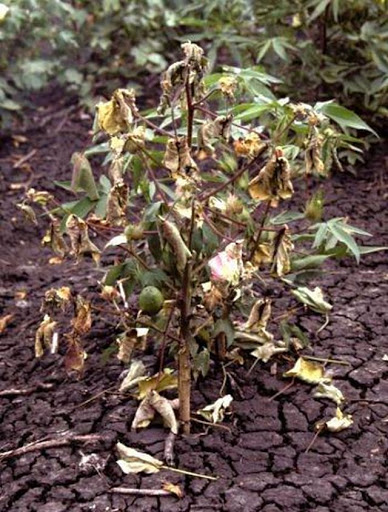
Exercise 7
CROP PLANTS WILTS
Wilts are the problems of crop plants having vascular root system and are caused by fungi and bacteria. These pathogens reside in xylem vessels and the latter then become cloggedwith the byproducts of the pathogens and extra-cellular enzymes of the plants. The extra-cellular enzymes of plants are produced in response to the attack of these pathogens. Browning of vascular tissues is the characteristic indication of wilts.Gram wilt (Fusarium oxysporum f.sp. cicerci), Verticillium wilt of cotton (Verticillium alboatrum), tomato wilt (Fusarium oxysporum f.sp. lycopersici) and cotton wilt (Fusarium oxysporum f.sp. vasinfectum) are prevalent in Punjab (Pakistan). However, Fusarium oxysporum and Verticillium alboatrum, are the most common wilt causing fungi and are found in warmer and colder areas, respectively.
Materials
Samples of above mentioned wilt affected plants.
Procedure
- Visit the field and critically observe symptoms of wilt in different crops.
- Examine brown tissues after cutting infected portion of roots.
- Observe the fungal mycelium in the infected tissues under microscope.
- Culture wilt causing fungi and draw sketches of mycelium, conidiophores and conidia.
Questions
- What is difference between biotic and abiotic wilts?
Biotic wilts are caused by pathogens (usually by fungi and bacteria) while abiotic wilts are caused by drought and excessive fertilization.
- What is difference between wilt and rot?
In wilts, bark of roots does not shredded off while in rots bark is shredded off. From rotted roots, ozz come out while from wilted roots ozz does not come out. Wilted roots are hard and come out of soil completely when pulled out while rotted roots are soft and when pulled out, do not come out from soil.
- What is vascular root system?
Vascular root system comprises xylem and phloem.
- What could be possible control measures of wilts?
Disease free seed. Soil fumigation. Crop rotation. Fungigation.
- How wilts perpetuate?
They perpetuate through soil and seed.


